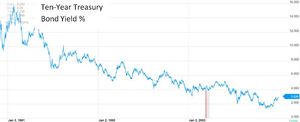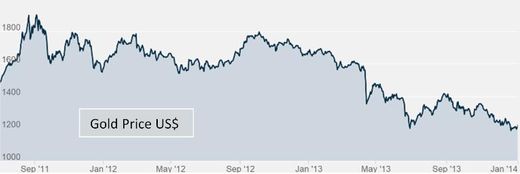2014 in review: A look behind central economic control
Twelve short months ago, the immediate future looked like a lock. Overvalued equities had to fall, ridiculously-low interest rates had to rise, and beaten-down precious metals had to resume their bull market.
The evidence was overwhelming. Debt in the developed world had risen to $157 trillion, or 376% of GDP, by far the highest level on record and clearly unsustainable. Long-term US Treasury rates had been falling for literally three decades and despite a recent uptick were so low that the only way forward seemed to be up.
Europe and Japan were drifting into recessions that could easily morph into capital-D Depressions. The eurozone would fragment, Japanese bonds and probably stocks would crater, one or more major currencies would implode. No way to know which event would come first and in what order the other dominoes would fall, but without doubt something had to give.
And gold, of course, had had its correction and was, at the beginning of 2014, perilously close to the mining industry's cost of production. The last time that happened, in 2008, an epic bull market ensued - and gold-bugs were anxious for a replay.
Yet 2014 turned out to be a pretty good year for the powers that be and the economic theories that animate their behavior. Equities boomed, interest rates fell, the dollar soared, and gold ended the year below where it started. Gold miners, after a year of operating at an aggregate loss, have seen their market values crater.
2014 should not have happened, but it did. There's no way to sugarcoat it: the gold bugs were wrong, Austrian economics was wrong, and the Keynesians were right. And now the sound money community is left trying to figure out what it missed and, crucially, whether the problem was merely one of timing or of fundamental worldview. With that in mind, a few explanations for the debacle that was 2014:
- Inflating away the world's reserve currency is a whole different animal. When a single not-very-important country decides to devalue its currency, it simply prints a lot of new pesos or whatever, and the exchange rate falls until a crisis ensues. That is not, however, how it works for the US because so much of the world's debt is linked to or denominated in dollars. Consider:
When you borrow money, you're in effect betting against, or shorting that currency because you benefit if it goes down in value. But at the same time you're creating future demand for it because in order to pay off the loan you have to acquire more of that currency. So the fact that so much of the world's debt is denominated in dollars means that demand for dollars is rising even as US debt increases. In the short run, this makes the dollar stronger despite America's deteriorating balance sheet. Add in the fact that the rest of the world is in even worse shape than we are, which makes the US look like a safe haven in relative terms, and the result is a strong dollar even in the face of soaring US liabilities.
- A fiat currency printing press is an amazingly powerful tool for fooling people. The world's governments have been able to use trillions of dollars of newly-created, largely-fictitious currency to force down interest rates across the yield curve and push up equity prices. This signals to market participants that 1) things are basically okay, so relax, 2) it's actually prudent to go for growth and yield by buying equities, junk bonds and houses, 3) it's reasonable to borrow for things like college and cars because there will always be plenty of money, one way or another, to cover those debts, and 4) betting against the status quo will be punished. Short sellers and savers will lose because equities will be secretly supported, competing forms of money like precious metals will be depressed, and cash will yield next to nothing.
- A global currency war allows the combatants to shift back and forth between easy and tight money for a really long time before anything serious happens. Between 2008 and 2013, the US and China were on the offensive, borrowing huge amounts of money and/or inflating central bank balance sheets. As a result, their currencies were relatively weak and they grew while Europe and Japan stagnated. Now it's the turn of the latter two to inflate while the former try to stabilize their debt loads. Aggregate global debt continues to soar, making the eventual financial crisis that much more catastrophic. But in the meantime the game of musical chairs can go on longer than it might for any individual country inflating alone.
- Debt is deflationary. The world is more heavily laden with bad paper than ever before. And while central banks' efforts to inflate this debt away is inflationary, the paper itself wants to implode, which is highly deflationary. These two forces have been contending for over a decade, with the advantage shifting back and forth. In 2008 deflation was ascendant, but by 2011 it looked like inflation had the upper hand. Now we're heading back into a deflationary stretch as the past few years' tight money in Europe and Japan push those two into recession and send global capital pouring into the supposed safe haven of US bonds and stocks.
So, back to the big question: Does the above refute the sound-money/gold-bug case, or simply delay it?
Almost certainly the latter. Rising dollar-denominated debt leading to a stronger dollar is not a perpetual motion machine. All it does is allow the US and the rest of the world to take on even more debilitating levels of debt than would otherwise be possible.
China, India, Russia and Brazil, meanwhile, are actively bypassing the dollar in favor of trading in their own currencies, while accumulating pretty much all the gold being produced by the world's mines. So the longer the current situation continues, the bigger the disruption when the dollar becomes just one of many global trading currencies.
Meanwhile, artificially depressing bond yields and supporting stock prices can only go so far before valuations (already crazy) become impossible to support with any amount of fiat currency. The yield on some Japanese bonds recently dropped below zero, and US 10-year treasuries are around 2%. US equity prices, margin debt, corporate share repurchases and most other measures of overvaluation are all in record territory. Unless we're moving to a world of negative interest rates (which is a whole different theoretical discussion) and dot-com era P/E ratios, the end for these trends is near.
So this has to and therefore will blow up. And when it does, the world's central banks will respond with debt monetization on a scale that will dwarf QE3 and Abenomics. "Inflate or die" will become official global policy. And gold will behave as it always does in such situations, by going parabolic.
But when? What seemed imminent a year ago now feels a little further out, as oil keeps falling (down another 2.5% as this is written on Dec 29), the dollar keeps rising and everything else is flat to down. Maybe instead of focusing on the numbers, which clearly don't mean as much as they would in a world of actual functioning markets, we should think in terms of philosophy and psychology. Here's a snippet from James Howard Kunstler that gets at the spirit of things without predicting "when things stop working".
"One reason this is happening to us is that we allowed reality to be divorced from truth. Karl Rove wasn't kidding back in the Bush-2 days when he quipped that 'we create our own reality'. The part old Karl left out is that there's a price for doing that. In the short run, it allows you to pretend that you have superpowers and can act in defiance of the way things really are. In the longer run, your view of the world comports so poorly with the facts of the world that things stop working. "




0 reacties:
Post a Comment